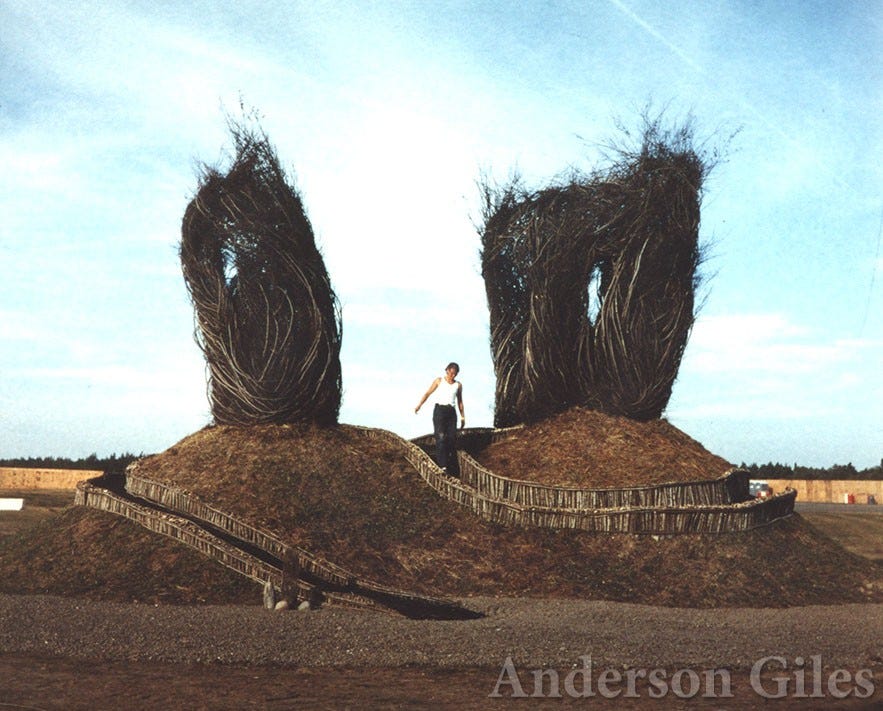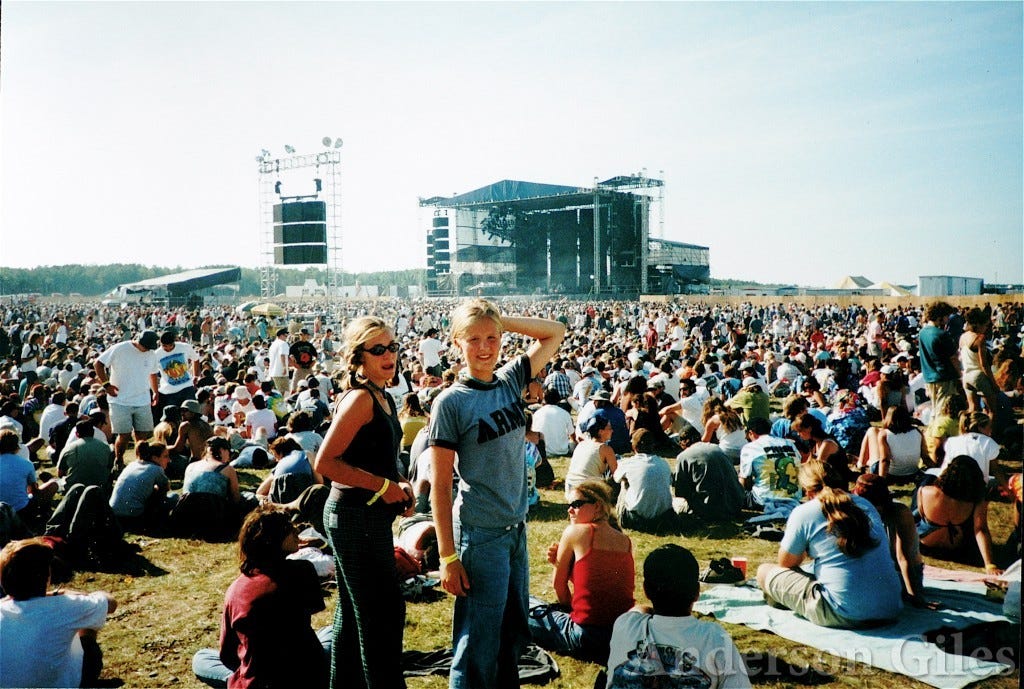SET 1: Mike's Song > Simple > Beauty of My Dreams, Roggae, Split Open and Melt, Poor Heart, The Moma Dance, Divided Sky, Water in the Sky > Funky Bitch > Cities > Weekapaug Groove
SET 2: The Wedge, Reba, Gumbo -> Sanity > Tweezer > The Horse > Silent in the Morning > Chalk Dust Torture, Slave to the Traffic Light
SET 3: NICU > David Bowie, Strange Design, Limb By Limb > Brian and Robert, Loving Cup
ENCORE: Halley's Comet > Cavern > Tweezer Reprise
SET 4: Ambient Jam
Listen on phish.in
Lemonwheel should have been the best of the 90s summer festivals, musically speaking. Being the third time through the full Phish festival experience, and the second time on the grounds of the former Loring Air Force Base, all the unknown factors were minimized. Lemonwheel also was the finish line of the best summer tour between 1996 and 1998, featuring a band that was fully warmed up and comfortable in their new stylistic skin. And yet, it feels like the neglected child of the band’s first three fests, without the euphoric novelty of the Clifford Ball or a defining jam that fans forever refer to as “The Lemonwheel _____.”
What Lemonwheel does have over its two siblings is the best “secret” set of the three, the late-night ambient “Ring of Fire” jam. For 51 minutes, Phish fulfilled the #1 dream of their most fervent fans: a zero-song set. Sure, you could describe the fourth sets of The Clifford Ball and The Great Went in the same way, but those bonus tracks had built-in peculiarities – the traveling flatbed of the first, the all-keyboards setup of the second. The after-midnight portion of Lemonwheel, meanwhile, took place on the main stage with the band’s standard setup, just with minimal lighting and a predefined musical intent.
Unlike the last two years, it was also not kept secret, as Trey tees up the entire concept at length in the encore of the show proper. There’s the light show, produced solely by fan-made candles and a circle of tiki torches surrounding the festival area. And then there’s the sound: “Our music that we’ll be playing is really intended to be almost kind of in the Brian Eno philosophy of ambient music…creating a different kind of music [from when] we get up here and make the big bang kind of thing, you know what I’m talking about.”
The kneejerk snark about Phish’s late-night set is that it’s not really ambient, it’s just instrumental – at least until they start cooing over the last few minutes. “Ambient” as a musical term, has become conflated with “minimal,” which Eno’s original Ambient series certainly was. But Eno’s founding definition of ambient music, written in the Music for Airports liner notes, was more nuanced and not really explicitly concerned with the volume or density of a piece. He wrote that “Ambient Music must be able to accommodate many levels of listening attention without enforcing one in particular; it must be as ignorable as it is interesting.“
Eno strived to differentiate his concept from the musical wallpaper of Muzak, also writing “Whereas conventional background music is produced by stripping away all sense of doubt and uncertainty (and thus all genuine interest) from the music, Ambient Music retains these qualities.” Improvisation was key to Eno’s original concept, which he executed through setting up tape loops of various durations and observing spontaneous harmonies, tension, and other emergent properties. I like his 1986 description of the method even more than the original:
Now the wonderful thing about that is that it starts to create music that you've never heard before. This is an important point I think. If you move away from the idea of the composer as someone who creates a complete image and then steps back from it, there's a different way of composing. It's putting in motion something and letting it make the thing for you.*
So while the Ring of Fire set really can’t be mistaken for Brian Eno’s music after basically the first ten minutes, I hope I’m not alone in seeing the relevance of the above to Phish, and particularly the point they had reached in 1998. On the most literal level, there’s Trey’s increasing use of loops** – my beloved “bweeoooo” – as a chaotic element in Phish jams, often darting in and out of sync with the band’s groove but producing new depth and texture as a result. It’s a process he’d continue to explore in the next two years, creating multiple automata on guitar (and eventually, keyboard) and composing loop soundscapes on the fly with his pedal foot.
But there’s a more powerful metaphorical analogy to be made to Eno’s generative process of creating music. Though he is perhaps most famous as a producer of artists like David Bowie, Talking Heads, and U2, Eno never permanently joined another band after he left Roxy Music. He’s a frequent collaborator, but usually in the sense of taking music made by others and manipulating it through technology. Music For Airports was an extreme case of this approach, taking a piano melody played by Robert Wyatt, some choir recordings, and other pre-recorded elements, winding them up like toys, and recording the best parts.
It would be rude to compare the members of Phish to 30-second tape loops. But the principle of setting four separate elements in motion and letting ideas bubble up spontaneously is a fairly good model for Phish, in their ideal state. It’s particularly apt for 1998, when the band was writing songs together more than ever before, and when the recording of their most recent album partially involved improvising in the studio and carving out “songs” at a later date. Live, the years of work they had put in to make the band an ego-free four-way conversation instead of the standard soloist/accompanist model was starting to pay off after the breakthroughs of 1997.
Of course the members of Phish are also not oblivious to each other, like the recorded pieces Eno used for juxtaposition. The confluences aren’t “ghost in the machine” happenstance, but the product of years of practice close listening and reacting to each other so fast that the lines blur between originator and responder. There’s also an element of, to use the technical term, keepy-uppy, where each strand can’t just end and restart like a loop, it has to adapt and evolve to always keep the music flowing without interruption. No shots at Eno’s experiments, but generative art is so much more magical and impressive when it can be made with the input of four humans at the peak of their musical talents, who have played with each other for thousands and thousands of hours.
The evidence is there in this set, which is sublime. It’s an incredibly high-wire act – or I should probably say, a “ring of fire” trick – for Phish to have pulled off after already having played four-and-a-half hours of music on 8/15, but maybe that extra exertion just softened them up in the necessary way. For 52 minutes without the guiding “rules” of a particular song’s jam structure, the full mercury sound of Phish democracy is unleashed. There are moments where it sounds like the purest improvisation they ever played.
It’s really impossible, maybe even irresponsible, to describe in words. It’s great music to write along with, but extremely difficult music to write about. Playing it over and over again for this essay, my ear is often drawn to the transitions between loosely defined segments of the jam: Page’s strident piano part at 16:10, the bittersweet melody that bubbles up in the 30th minute. But I’m a blind man describing parts of the elephant here; those elements are interesting as classic “yes, and…” bridges that kept this plane in the air, while the meatier portions of the jam just pleasantly wash over me.
I will mention a section starting around the 35th minute where the jam is most ridiculously in violation of the “ambient as minimal” definition. Trey starts playing a sinewy thread that gradually progresses into crunchy power chords, Fish remembers he has a snare drum at his disposal, and before you know it the band is stomping around like they’re approaching the peak of a Tweezer. It’s the moment that most sounds like they’re playing “in the Brian Eno philosophy of ambient music” as a set of starting rules, not as a musical genre they’re trying to reproduce like one of their Halloween costumes. And it turns out those constraints still allow them to arrive at “the big bang kind of thing,” because it’s an essential part of the Phish experience that can’t help but bleed out.
That moment kind of answers the question that this set begs: should Phish blow off songs entirely and just do this all the time?*** As much as I’m enthralled with sets like this one and the later Storage and Drive-In Jams, I think the answer has to be no – there’s too much gravitational pull towards the traditional structures of arena rock in their DNA, such that shows like 8/12 are just as true reflections of Phish as this early-morning one-off. As much as I focus on the improvisational side of Phish, it’s only part of their full personality, and it would be a shame to strip it down to just one dimension. But every once in a while, it sure is nice to hear it in isolation, as ignorable as it is interesting.
[Thank you once again to the University of Maine at Presque Isle for maintaining an archive of Lemonwheel photos!]
* - Eno also compares it to Conway’s Game of Life, a famous computational simulation of evolution. So he’s a man after my own heart.
** - A curious thing about this ambient jam: hardly any loops! Or effects at all, really. Compared to the Storage or Drive-In Jams, it’s relatively clean tone Phish.
*** - Or to put it another way, should they become The Necks?








Great stuff, Rob. I've been looking forward to your thoughts on this for a few years.
The ambient set was the first tape I got, back in the B&P days of RMP. Not exactly the most accessible or accurate entry point, but it didn't turn me off the band. Twenty-five years later, I listen to it a lot along with the great ambient mixes on YouTube, and I listen to Music for Airports several times a week.
Nice write-up on the “ambient” jam but I think people, like this review, are guilty of overlooking the Gumbo>Sanity>Tweezer. Spectacular Gumbo followed by one of the best/coolest/most surprising segues ever into Sanity. Sanity also has a Floyd-ish vibe to it. Highlight of the festival for me and deserves way more credit.